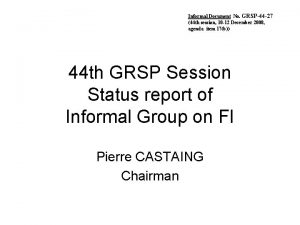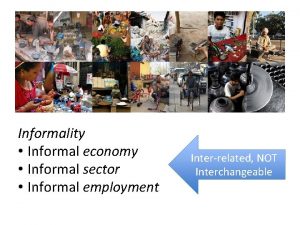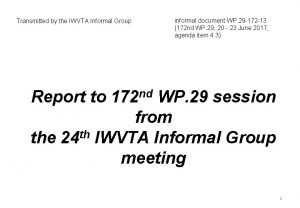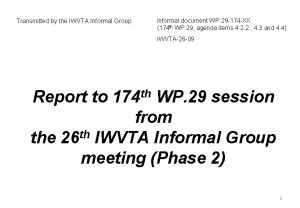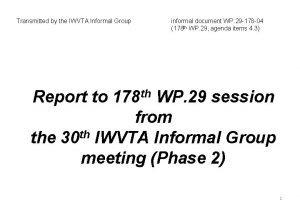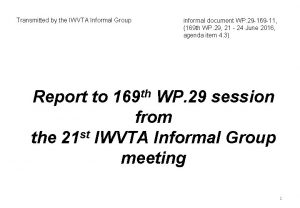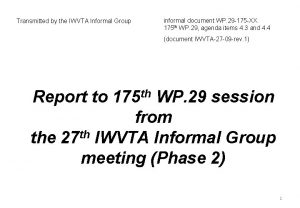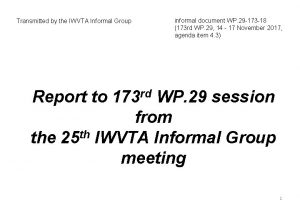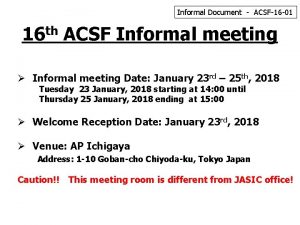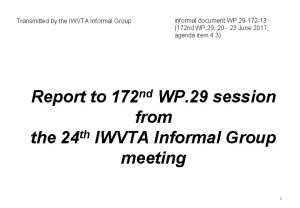Informal Document ACSF03 09 Presentation for Document ACSF03















![FU 2 [new] (Lane change test) Þ A new test will be proposed by FU 2 [new] (Lane change test) Þ A new test will be proposed by](https://slidetodoc.com/presentation_image_h/25c4a599a2bd4c88507312fda09b630d/image-16.jpg)





- Slides: 21

Informal Document ACSF-03 -09 Presentation for Document ACSF-03 -03_rev 1 Oliver Kloeckner 2. -3. September 2015 3 rd meeting of the IG ASCF Munich, Airport www. bmvi. de

Requirements for ACSF www. bmvi. de

Structure of the ASCF requirements Definitions for ACSF 5 categories new terms Special Warning Provisions for ACSF In case of termination of control In case of sudden termination of control Special Provisions for ACSF General Operation of ACSF System information data Transition demand Minimum Risk Manoeuvre

Definitions for ACSF 5 categories new terms Content : • Category 1 ACSF: a function that operates at a speed no greater than 10 km/h to assist the driver, on demand, in low speed manoeuvring or parking operations. • Category 2 ACSF, t. b. d. by OICA • Category 3 ACSF, a function that operates at a speed no greater than [130 km/h] and which can perform a single manoeuver (e. g. lane change) when commanded by the driver. • Category 4 ACSF, a function that operates at a speed no greater than [130 km/h] and which can indicate the possibility of a single manoeuvre (e. g. lane change) but performs that function only following a command confirmation by the driver. • Category 5 ACSF, a function that operates at a speed no greater than [130 km/h], which is initiated by the driver and which can continuously determine the possibility of a manoeuvre (e. g. lane change) and complete these manoeuvers for extended periods without further driver command/confirmation.

Definitions for ACSF 5 categories new terms (Main) Content : • • “Motorway” means, a road section, dedicated exclusively to motor vehicles, having [a speed limit of more than 100 km/h and] at least two traffic lanes for each direction of travel and having a physical separation of traffic moving in opposite directions "Transition demand " means an instruction from the ACSF to the driver that they have to take over manual control of the steering task again "Minimum risk manoeuvre" means a procedure to reach a status with as little risk as possible in the given traffic situation, when the driver fails to respond to the takeover request "Emergency Manoeuvre” is a manoeuvre performed by the system in case of a sudden unexpected event in which the vehicle is in imminent danger to collide with another object, in order to avoid or mitigate a collision

Special Warning Provisions for ACSF In case of termination of control In case of sudden termination of control Content : • • • Any termination of control or a transition demand shall produce a distinctive driver warning by a [yellow or red] visual signal and either an acoustic signal or by imposing a haptic warning signal. This warning shall be provided before the system (function) becomes inoperational, if the termination is not intended by the driver. If the driver does not take over manual control, the warning shall be escalating with time in terms of enlarging the intensity of the warning and/or in terms of adding and/or changing the warning means

Special Warning Provisions for ACSF In case of termination of control In case of sudden termination of control Content : • Any sudden termination of control caused by a failure of the system physical or functional failure shall produce immediately a distinctive driver warning by a [red] visual signal and either an acoustic signal that shall remain operational until the driver has resumed control.

Special Provisions for ACSF General Operation of ACSF System information data Transition demand Minimum Risk Manoeuvre Content : • • Vehicle shall have a means to activate or deactivate the system System can only be activated, if conditions for safe operation are fulfilled System shall be able to detect, if the driver is steering manually system shall not induce a lateral acceleration of more than [3] m/s system shall comprise an attention recognition system Vehicle shall not induce any safety critical situations and the movements of the vehicle shall be clear to other road users System shall at any time give a noticeable and distinctive signalization to the driver about the system status

Special Provisions for ACSF General Operation of ACSF System information data Transition demand Minimum Risk Manoeuvre Content : • • • Requirements for a lane change manoeuvre Activation of direction indicator Lane change manoeuvre shall be completed, except the system detects an imminent critical situation or the system is overridden by the driver System shall ensure a safe lateral distance to other road users If the system detects an unexpected imminent danger (e. g. impending collission), an emergency manoeuvre shall be carried out Attention recognition system, warning if driver is inattentive

Special Provisions for ACSF General Operation of ACSF System information data Transition demand Minimum Risk Manoeuvre Content : Data to be provided to the Techn. Service (together w. the documentation pack. ) • • • Values for Vsmax and Vsmin Conditions under which the system can be activated Information about system boundaries at which the activated system shall issue a transition demand Specific values for time intervals which are foreseen for safe transition to manual steering under different circumstances Documentation about the chosen strategies regarding the minimum risk manoeuvre which is foreseen depending on the given traffic situation Documentation about the chosen strategies regarding the emergency manoeuvre

Special Provisions for ACSF General Operation of ACSF System information data Transition demand Minimum Risk Manoeuvre Content : • • • The timing of the transition demand shall be such that sufficient time is provided for a safe transition to manual steering Transition demand shall be provided by a [yellow] visual signal and either an acoustic signal or by imposing a haptic warning signal Transition demand shall be provided, if - system detects that its boundaries are reached or will be reached shortly or in case of a system failure - the speed of the vehicle with activated ACSF exceeds vsmax - the vehicle reaches a lateral acceleration of more than [3] m/s² - the attention recognition system detects the driver to be inattentive although a warning to restore attentiveness was provided - driver's seatbelt is unfastened and/or if driver's seat is left by the driver

Special Provisions for ACSF General Operation of ACSF System information data Transition demand Minimum Risk Manoeuvre Content : • If the system detects that after a transition demand the driver does not take over manual control of the steering again the vehicle shall carry out a minimum risk manoeuvre

Tests for ACSF www. bmvi. de

What is covered by the current tests of Annex 7 ?

FU 1 (lane keeping test) Check if vehicle stays on path under normal operating conditions (lead vehicle is optional) • • at least 5 min driving on a track with various curvatures with road markings of good visibility at each side of the lane at various speeds up to vsmax and down to vsmin drive within the lane markings with ay ≤ 1 m/s² The usage of a lead vehicle is optional If test is performed with a lead vehicle, the time gap shall be 2 s to 3 s or could be adjusted automatically by the system al ion opt Test is passed: Vehicle does not cross any lane marking
![FU 2 new Lane change test Þ A new test will be proposed by FU 2 [new] (Lane change test) Þ A new test will be proposed by](https://slidetodoc.com/presentation_image_h/25c4a599a2bd4c88507312fda09b630d/image-16.jpg)
FU 2 [new] (Lane change test) Þ A new test will be proposed by OICA This test shall replace the former test EM 3 (abortion of a lane change), as the discussion showed, that EM 3 seems to be very complex and difficult to realise.

TR 1 (tight curve: ay beyond system boundaries) Check transition demand minimum risk maneuvre (lead vehicle is optional) optional • driving at least 1 min behind on a track with road markings of good visibility at each side of the lane at a speed of 10 km/h below vsmax • after a straight section of at least 200 m the vehicle shall approach a curve of more than 90° that would demand an ay of more than [3] m/s² • test driver shall not take over manual steering control again before the minimum risk maneuvre is finished • The usage of a lead vehicle is optional Test is passed: • transition demand was given at least when the lateral acceleration exceeds [3] m/s² • the minimum risk maneuver as specified by the manufacturer was initiated • vehicle does not cross any lane marking before the minimum risk maneuvre was initiated.

TR 2 new (missing lane marking) Check transition demand minimum risk maneuvre (lead vehicle is optional) • driving at least 1 min on a track with road markings of good visibility at each side of the lane at a speed of 10 km/h below vsmax • after a straight section of at least 200 m the vehicle shall approach a section with a length of 200 m with only one lane marking at the driver‘s side • test driver shall not take over manual steering control again • The usage of a lead vehicle is optional Test is passed: • the transition demand is given before the vehicle is entering the section with missing lane markings and the vehicle shall follow the initial path for at least [5] seconds after the transition demand the minimum risk maneuver as specified by the manufacturer was initiated, or • the vehicle follows the initial path for the complete section with only one lane marking without crossing any lane marking.

EM 1 (Braking behind lead vehicle) Basic automatic emergency braking capability if lead vehicle suddenly decelerates sharply • • • 6 m/s 2 Test speed of both vehicles 10 km/h below vsmax Initial time gap 3 s Lead vehicle deceleration 6 m/s², mean jerk 6 m/s³ 3 s Test is passed: No collision

EM 2 (Braking behind motorcycle) Basic emergency braking capability (motorcycle stands statically in the lane) • • • Test speed 10 km/h below vsmax L 3 motorcycle stands centered in the lane Test is not feasible for ACSF systems, which are only working with lead vehicle L 3 motorcycle target Test is passed: No collision

Thank you for your attention! Federal Ministry of Transport and Digital Infrastructure Robert-Schuman-Platz 1 D-53175 Bonn www. bmvi. de
 Ejemplos de norma inculta formal
Ejemplos de norma inculta formal Informal document
Informal document Javascript:document.write(document.cookie)
Javascript:document.write(document.cookie) Kontinuitetshantering
Kontinuitetshantering Typiska drag för en novell
Typiska drag för en novell Nationell inriktning för artificiell intelligens
Nationell inriktning för artificiell intelligens Vad står k.r.å.k.a.n för
Vad står k.r.å.k.a.n för Varför kallas perioden 1918-1939 för mellankrigstiden
Varför kallas perioden 1918-1939 för mellankrigstiden En lathund för arbete med kontinuitetshantering
En lathund för arbete med kontinuitetshantering Underlag för särskild löneskatt på pensionskostnader
Underlag för särskild löneskatt på pensionskostnader Tidböcker
Tidböcker Sura för anatom
Sura för anatom Förklara densitet för barn
Förklara densitet för barn Datorkunskap för nybörjare
Datorkunskap för nybörjare Stig kerman
Stig kerman Mall för debattartikel
Mall för debattartikel För och nackdelar med firo
För och nackdelar med firo Nyckelkompetenser för livslångt lärande
Nyckelkompetenser för livslångt lärande Påbyggnader för flakfordon
Påbyggnader för flakfordon Kraft per area
Kraft per area Publik sektor
Publik sektor Urban torhamn
Urban torhamn

